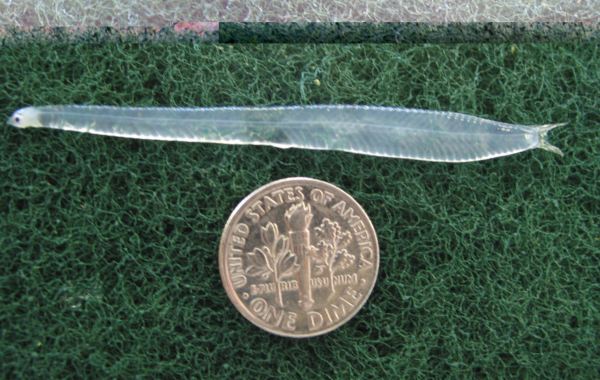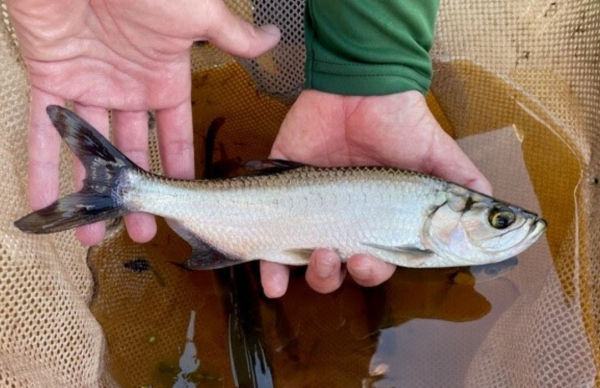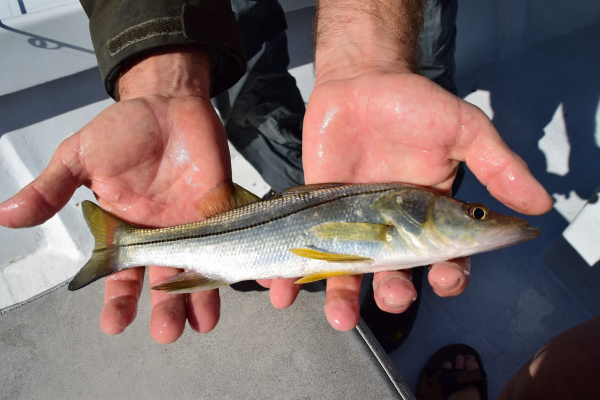Florida’s Fish & Wildlife Research Institute scientists are an intrepid lot, always ready to hose down with DEET and head for the saltmarshes in pursuit of fishy knowledge.

Larval tarpon look nothing like their adult selves. The tiny, transparent creatures are capable of worming their way into marsh ponds far from the estuaries, where they survive to grow into their fishy adult shapes. (B&TT)
But they outdid themselves in the recently released study on baby snook and tarpon done in the Cape Haze area of the state’s southwest coast, spending months slogging the backwaters on the north side of Charlotte Harbor in country where you often inhale more no-see-ums than air, black mud can be knee deep and where mosquitoes can almost darken the skies at times.
The results were worth it, they will tell you, and we can’t disagree—the state now has a proven handle on the habitat that works best for survival of the juveniles of these two prime gamefish species.
And particularly for tarpon, it’s pretty amazing.
Landlocked Tarpon
Baby tarpon were often found in ponds and marshes completely cut off from coastal waters, in some cases hundreds of yards from the nearest shore.
How do they get there?
The biologists believe that the miniscule, flat-sided “elver” stage of nearly transparent larval tarpon, spawned far offshore, ride the tides back into the estuaries, with the few survivors worming their way back into these areas on the thinnest wet film of a king tide. They actually push their way through marsh country that is dry most of the time.
Assuredly most are eaten long before they even get there and many of them wind up stranded in this instinctive push toward hidden refuges. But enough of them make it to reprime the pump and start another generation of fish in that given marsh.
Some of the blackwater marshes are so devoid of oxygen that most fish species can’t survive there an hour let alone long enough to grow to any size, but the air-gulping baby tarpon get along just fine—and have no fishy predators to worry about, though there are plenty of crabs, birds, lizards and snakes.

Tarpon Juvenile: At a year, juvenile tarpon look more like themselves, but they still have many years remaining before they reach adult size. (B&TT)
When they get big enough to fend for themselves—around 10”to 12” after 12 months in the marsh—the juvenile tarpon wait for another king tide like the one that brought them in to get them out of the backwater and into the open estuary, where they can proceed down tidal creeks to the bays and sounds where they’ll grow up over 8 to 10 years to become the high-flying silver king that’s the poster child of Florida fishing.
Baby Snook Hideouts
Juvenile snook were most often found in ponds connected directly to the larger creeks by some form of flowing water, and rarely or never in ponds not somehow connected to open water—snook apparently don’t infiltrate across thick marsh to reach nursery ponds like tarpon do. (The fact that there was no evidence of baby tarpon in these more open basins may indicate snook or some other predator makes survival less likely for the silver king at this miniscule life stage.)
Where baby snook are found, there tend to be lots of them, enough that the researchers could run nets around the pods and count them. As you’d expect, the basins with the most oxygen generally had the most baby snook.
Not many of these babies make it to adulthood. Scientists estimate that only 1 to 4 juveniles from the millions spawned by any given female each year make it to adulthood. But put them all together, in good habitat, and a well-managed fishery continues to thrive.

Juvenile Snook: Juvenile snook thrive in well-oxygenated tidal ponds and creeks connected to open water, unlike baby tarpon. (B&TT)
As an aside, not surprisingly the open creeks and bays near the research sites are well-known hangouts for adult snook (as well as redfish) throughout the warmer months here.
Protection of Florida’s “Useless Swamps”
Once again, the study indicates that the Florida land most humans see as least useful—noxious, in fact—is among the most valuable as fish and wildlife habitat. The first land drained and filled in development of the state’s coast was mangrove and marsh, and we now learn that hostile habitat, to us, is not only welcoming but essential to the state’s most iconic fish species.
Fortunately, nearly all of this land is now protected, but there are frequent efforts by developers to make an end run around environmental rules to convert this “useless” land to cash.
You can see the original report here: https://link.springer.com/article/10.1007/s13157-024-01844-1
To learn more about protecting Florida’s premiere inshore fish species, visit Bonefish & Tarpon Trust at www.bonefishtarpontrust.org.
— Frank Sargeant
Frankmako1@gmail.com